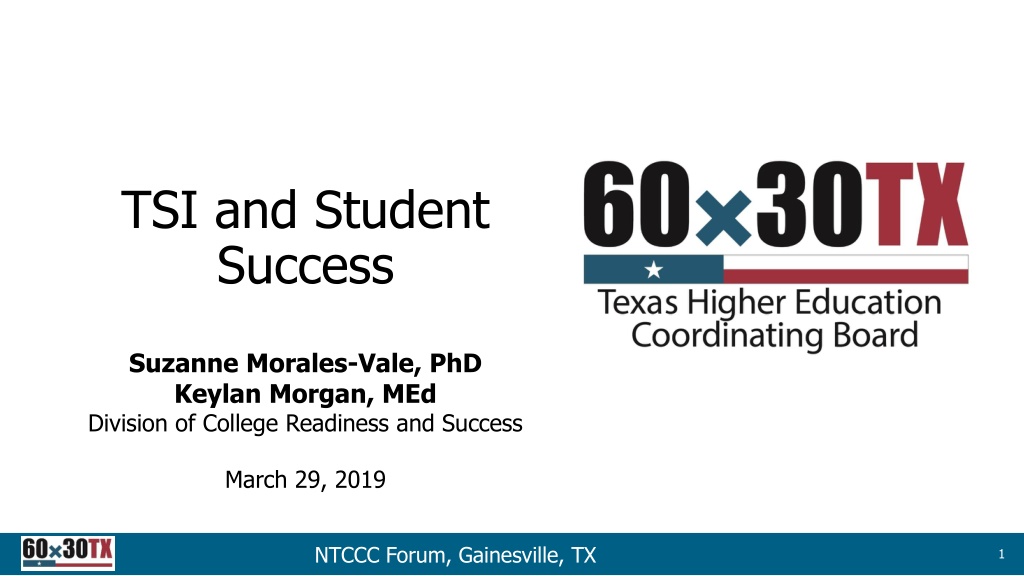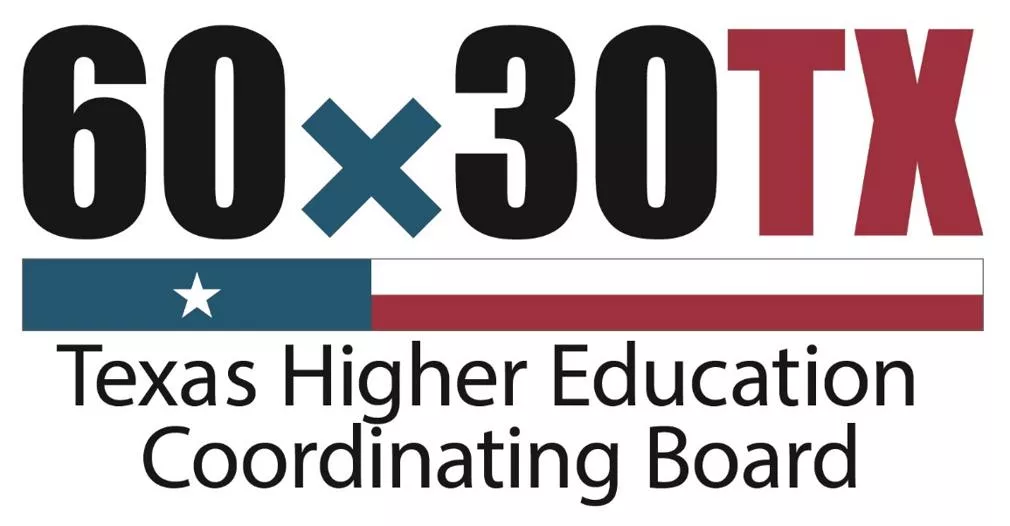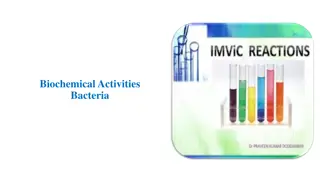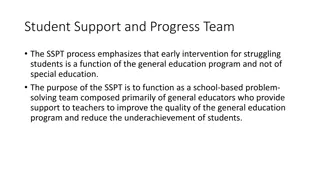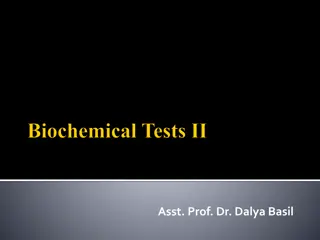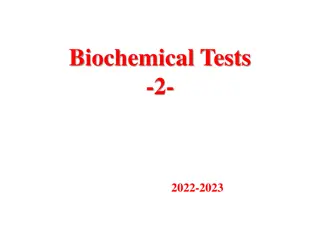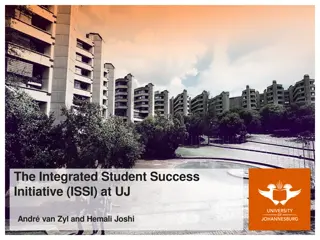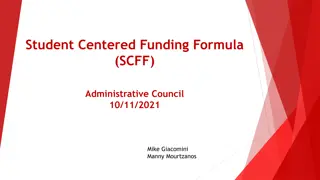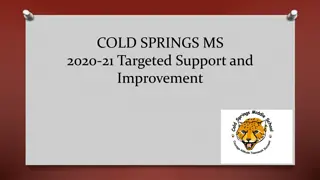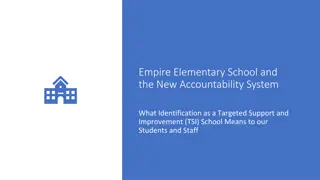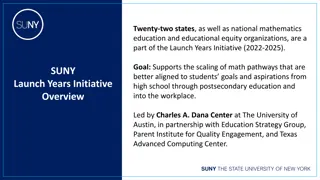TSI and Student Success Agenda Overview
This presentation delves into topics such as Texas Higher Education Strategic Plan, College Readiness Definitions, TSI Policy Updates, and more. It discusses the demonstration of college readiness, dual credit eligibility, and the differences in definitions provided by THECB and TEA. The material also covers TEXAS College, Career, and Military Readiness criteria. Through images and text, valuable insights are shared for understanding student success in the academic landscape.
Download Presentation

Please find below an Image/Link to download the presentation.
The content on the website is provided AS IS for your information and personal use only. It may not be sold, licensed, or shared on other websites without obtaining consent from the author.If you encounter any issues during the download, it is possible that the publisher has removed the file from their server.
You are allowed to download the files provided on this website for personal or commercial use, subject to the condition that they are used lawfully. All files are the property of their respective owners.
The content on the website is provided AS IS for your information and personal use only. It may not be sold, licensed, or shared on other websites without obtaining consent from the author.
E N D
Presentation Transcript
TSI and Student Success Suzanne Morales-Vale, PhD Keylan Morgan, MEd Division of College Readiness and Success March 29, 2019 NTCCC Forum, Gainesville, TX 1
Agenda Overview of Texas Higher Education Strategic Plan (60x30TX) Overview of College Readiness Definitions Trends TSI Policy Updates TSIA Writing Benchmark HB 2223 Implementation Rules and Policies HB 2223 Reporting TSIA, Version 2.0 Resources/Support Q&A 2
College Readiness Definitions and Trends 4
Demonstration of College-readiness and TSI Exemptions TSIA scores ACT scores SAT scores STAAR EOC English III and Algebra II (4000) HS College Preparatory Course Successful completion of a college-level course as accepted by the receiving institution 5
THECB Definition of College Readiness Differs From: Dual credit eligibility TEA definition of college readiness, postsecondary, college, career, and military readiness (CCMR) 6
Dual Credit Eligibility vs. College Readiness Dual Credit Eligibility- not a college readiness benchmark but allows qualifying students to ENROLL in a college-level course (by subject area(s)): PSAT-MNSQT/Aspire English II EOC (4000) Algebra I EOC (4000) + Algebra II course (grade of A, B, or C) TAC, Section 4.85 Students meeting above eligibility requirements are not considered college ready until successful completion of the college-level course (grade of A, B, or C) 7
TEA: College, Career, and Military Readiness (CCMR) 4/20/18 College Ready Meet criteria of 3 on AP or 4 on IB examinations Meet TSI criteria (SAT/ACT/TSIA/College Prep course) in reading and mathematics Complete a course for dual credit (9 hours or more in any subject or 3 hours or more in ELAR/mathematics) Earn an associate s degree Complete an OnRamps course* Meet standards on a composite of indicators indicating college readiness* *Implementation in 2019 & beyond / 8
TEA: College, Career, and Military Readiness (CCMR) 4/20/18 Career Ready Earn industry-based certification CTE coherent sequence coursework completion and credit aligned with approved industry-based certifications (one-half point credit) Graduate with completed IEP and workforce readiness (graduation type code of 04, 05, 54, or 55) Be admitted to postsecondary industry certification program* Military Ready Enlist in the United States Armed Forces *Implementation in 2019 & beyond 9
College readiness of incoming cohorts increased in 2017 after two years of declines Percentage of Fall FTIC Cohort who Enter College-Ready, By Subject: Statewide 100% 90% 80% Percent College Ready 70% 60% 50% 40% 30% 20% 10% 0% 2012 71% 80% 80% 63% 2013 74% 81% 80% 66% 2014 73% 83% 83% 68% 2015 63% 76% 78% 57% 2016 59% 72% 74% 54% 2017 64% 79% 85% 60% Math Reading Writing All Areas Source: CBM002 10
60 percent of first-time entering students in Fall 2017 were college ready. Statewide Not College Ready College Ready 60.3% Universities Two-year colleges 15.8% 39.7% 41.7% 58.3% 84.2% Not College Ready College Ready Not College Ready College Ready
Almost half of non-college-ready students from Fall 2016 remained not-ready after 1 year 60% 23% 17% MATH Not College-Ready 41% 20% 39% READING College-Ready, No First College-Level Course completion Completed First College-Level Course 45% 23% 32% WRITING 0% 10% 20% 30% 40% 50% 60% 70% 80% 90% 100% 12
Math continues to be the subject with the most students who are not college-ready and also have the lowest FCLC completions after a year UNIVERSITIES (FALL 2016 COHORT, 1- YEAR FOLLOW UP) Not College-Ready College-Ready, No FCLC completion Successfully completed FCLC 40% 28% 31% MATH 21% 20% 58% READING 22% 25% 53% WRITING 2-YEAR COLLEGES (FALL 2016 COHORT, 1-YEAR FOLLOW UP) Not College-Ready College-Ready, No FCLC Completion Successfully Completed FCLC 64% 22% 14% MATH 44% 20% 36% READING 49% 23% 28% WRITING 13
Successful completion of FCLC has increased over past 5 years Percent of Non-College-Ready Students who Complete a FCLC in non-ready subject within one year, Statewide 50% 45% 39% 37% 40% 32% 35% 30% 29% 24% 27% 22% 30% 24% 21% 24% 19% 25% 17% 20% 16% 15% 11% 7% 10% 6% 6% 5% 0% 2011 2012 2013 2014 2015 2016 Math Reading Writing 13
Graduate rates at two-year colleges are 10 percentage points higher for college ready students compared to students who enter not college-ready. Status after 3-years (2014 Entering Cohort) 100% 90% 80% 70% 60% 60% 50% 41% 40% 30% 25% 20% 15% 10% 0% Graduated Graduated or Still Enrolled College Ready Not College Ready 15
At universities, graduate rates are more than 30 percentage points higher for college ready students Status after 6-years (2011 Entering Cohort) 100% 90% 80% 74% 70% 65% 60% 50% 45% 40% 32% 30% 20% 10% 0% Graduated Graduated or Still Enrolled College Ready Not College Ready 16
Table 1: ABE Levels, by Subject, as Percent of Total Population Classified as Underprepared % Total Underprepared Population 0.05% 0.14% 0.62% 3.69% % Total Underprepared Population 0.08% 0.18% 0.71% 3.89% Reporting Year 16 Reporting Year 17 Diagnostic Score ABE Math Score = 1 Score = 2 Score = 3 Score = 4 Score = 1 207 569 2,529 15,065 331 796 3,067 16,807 ABE Reading 68 0.03% 81 0.03% Score = 2 453 0.18% 568 0.22% Score = 3 467 0.19% 525 0.21% Score = 4 3,986 1.62% 4,260 1.66% Score = 1 ABE Writing 239 0.09% 405 0.15% Score = 2 238 0.09% 212 0.08% Score = 3 1,134 0.44% 1,146 0.43% Score = 4 5,256 2.05% 5,823 2.18% Source: Reporting Year(s) 2016, 2017 CBM002, TX Higher Education Coordinating Board 17
Table 2: BASE NCBO Enrollments by Reporting Year Reporting Year Students Enrollments 2016 3,096 3,528 BASE NCBO Enrollments grew by 1,794 between 2016 and 2017. With 1,521 more students making up those enrollments. 2017 4,617 5,322 Source: Reporting Year(s) 2016, 2017 CBM00S, TX Higher Education Coordinating Board 18
Table 3: CERT 1 Completions by Reporting Year Change in Number of Completions Reporting Year Cert 1 Students Completions 2015 28,232 32,007 CERT 1 Completions have grown over the past two years. In 2017, CERT 1 completions outpaced the population of students that pursued the program. 2016 28,015 32,382 +375 2017 28,857 33,237 +855 Source: Reporting Year(s) 2015, 2016, 2017 CBM009, TX Higher Education Coordinating Board 19
Policy Updates TSIA Writing Benchmark HB 2223 Implementation Rules and Policies HB 2223 Reporting TSIA, Version 2.0 20
TSI Assessment Rule Change Effective the institution s first class of fall 2017, the following minimum passing standards for reading , math, and writing on the TSIA shall be used to determine a student s readiness to enroll in entry-level freshman coursework: Math - 350 (no change) Writing - Placement score of at least 340 and an essay score of at least 4 Placement score of less than 340, and ABE Diagnostic Level of at least 4, and an essay score of at least 5 Reading- 351 (no change) 21
Understanding HB 2223 Requires each IHE to develop and implement for developmental education a corequisite model(s) Each institution shall ensure that at least 75 percent* of the institution's students enrolled in developmental coursework, other than adult basic education or basic academic skills education, are enrolled in developmental coursework described by this subsection. *phased-in over 3 year period: 25% fall 2018; 50% fall 2019; 75% fall 2020 22
Definition of Corequisite (aka Mainstreaming, Co-Enrollment, Course Pairing) Rule 4.53(7): Co-requisite (also known as corequisite or mainstreaming)--An instructional strategy whereby undergraduate students as defined in paragraph (24) of this section are co-enrolled or concurrently enrolled in a developmental education course or NCBO, as defined in paragraph (18) of this section, and the entry-level freshman course of the same subject matter within the same semester. 23
Definition of Corequisite (aka Mainstreaming, Co-Enrollment, Course Pairing) Rule 4.53(7): (continued) The developmental component provides support aligned directly with the learning outcomes, instruction, and assessment of the entry-level freshman course, and makes necessary adjustments as needed in order to advance students' success in the entry- level freshman course. Participation in the entry-level freshman course is not contingent upon performance in the developmental education component of the corequisite.* *sequential models 24
Definition of Undergraduate Rule 4.53(24): (24) Undergraduate student a student, other than a high school student enrolled in college-level coursework for dual credit, who enrolls at a Texas public institution of higher education in a field or program of study. Corequisite models are for high school complete students only 25
When do HB 2223 requirements take effect? 2018-2019: At least 25% of the IHE's students enrolled in DE coursework must be enrolled in corequisite models 2019-2020: At least 50% of the IHE's students enrolled in DE coursework must be enrolled in corequisite models 2020-2021: At least 75% of the IHE's students enrolled in DE coursework must be enrolled in corequisite models How measured? By subject area By institution or campus (per CBM reporting) By semester, including summer 26
Which students are exempt? (unduplicated) STUDENT IS ENROLLED IN A DE COURSE/ INTERVENTION AND (i) assessed at ABE Diagnostic levels 1-4 on the TSI Assessment* or enrolled in BASE NCBOs; (ii) is reported as college ready; (iii) enrolled in adult education/AEL or reported with ESOL waiver; (iv) enrolled in a degree plan not requiring a freshman level academic mathematics course; OR (v) meets one or more of the exemptions as outlined in 4.54 (relating to Exemptions, Exceptions, and Waivers) *initial semester only 27
HB 2223 Applies To The Following Students: STUDENT IS ENROLLED IN A DE COURSE/ INTERVENTION AND Students with TSIA Developmental Education Diagnostic results (e.g., TSIA math 336-349); Students with TSIA ABE Diagnostic results of Levels 5 and 6; OR Underprepared students enrolled in developmental education courses/interventions not otherwise exempt 28
Additional Changes from HB 2223 Texas Success Initiative (TSI) statute relocated Section 51.3062 changes to Article I, Section 1.01, F-1 DE Hours Eligible for Funding are Reduced Section 51.340 Universities: Reduced from 18 hours to 9 hours Community Colleges: Reduced from 27 hours to 18 hours ESOL: Remains at 18 hours/Universities and 27/CC 29
Clarification- starting Spring 2019 Only IRW DE courses will count as a corequisite model for HB 2223 CIP Approval Codes (e.g., CTCs) 32.0108.59 12 32.1018.60 12 The following courses/interventions will no longer count as part of a corequisite model (e.g., CTCs) DE Reading 32.0108.52/61 12 DE Writing 32.0108.53/62 12 30
Reporting for HB 2223 Percentage of DE students in corequisite models will be determined through CBM reports State reporting officials provide THECB data on: College-readiness status of each student TSIA and ABE Diagnostic level scores TSIA waiver and exemption status Developmental coursework taken by each student (i.e., subject and type of DE instruction) Communication with your institution s reporting official is important ensure corequisite models are being reported correctly ensure exemptions are being reported correctly For questions about reporting, please contact Melissa Humphries (THECB): Melissa.Humphries@thecb.state.tx.us, (512) 427-6546 31
Reporting for HB 2223 Your institution s reporting administrator has received several emails with your institution s fall 2017 and spring 2018 HB 2223 calculations Serves as a checkpoint to determine if your institution is reporting correctly Annual DEPS 2018 - DE Report, approved by the Board and sent to Governor and Legislators, reports in aggregate and by-institution progress on HB 2223 Report follow-up will be based on verified CBM data, expected spring 2019 Participation as required by HB 2223 Fall 2019 corequisite outcomes Future reports will include longitudinal data 32
DE Report January 2019 DE Report, approved by the Board and sent to Governor and Legislators, reports in aggregate and by-institution progress on HB 2223 Report follow-up will be based on verified CBM data, expected spring 2019 Participation as required by HB 2223 Fall 2019 corequisite outcomes Future reports will include longitudinal data 33
DE Report January 2019 Includes 4 Recommendations for Serving Underprepared Students Developmental education is delivered via corequisite models by 2023; All community colleges have access to Adult Education and Literacy programs, either directly or through partnerships; All students completing the high school College Preparatory Course (Section 28.014) be administered the TSI Assessment; Funding for serving underprepared students addresses all students, including those identified as not college- ready and those college-ready but are still struggling. 34
New items included: 2 questions about HB2223 implementation costs 2 questions about placement; one for Math Pathways, and another for IRW Developmental Education Program Survey (DEPS) The Developmental Education Program Survey (DEPS) is administered through the Texas Higher Education Coordinating Board (THECB) and contains items related to DE student placement, DE course and intervention options, and college preparatory courses. The registered DEPS contact for your institution is responsible for the completion of this survey as part of the evaluation requirement in accordance with TAC 4.60. THECB Reporting on the DEPS The DEPS will be used to report corequisite percentages for fall 2018 CBM used as addendum once available Preliminary Findings 35
DEPS: Preliminary Findings - Overview 65 32 Public Community and Technical Colleges Public Universities 8,361 Corequisite Enrollments 40,401 Corequisite Enrollments 84% 94% 72% 92% Meeting the 25% Math Corequisite Enrollment Goal Meeting the 25% IRW Corequisite Enrollment Goal Meeting the 25% Math Corequisite Enrollment Goal Meeting the 25% IRW Corequisite Enrollment Goal 36
DEPS: Preliminary Findings Statewide Overview 37% 52% of eligible DE students are enrolled in a corequisite model for Math of eligible DE students are enrolled in a corequisite model for IRW 76% 93% of institutions met the 25% corequisite enrollment goal for Math of institutions met the 25% corequisite enrollment goal for IRW 37
DEPS: Preliminary Findings - Challenges & Investments Top 3 Implementation Challenges Top 3 Investments for Implementation Scheduling corequisite course sections/support Costs associated with enhancing academic support services (e.g. supplemental instruction, tutoring, math / writing lab etc.) Providing sufficient number of qualified faculty to teach in a corequisite model Professional development for instructors of new developmental education courses Communicating between faculty and advisors about corequisite options Compensation to faculty for curriculum development or course redesign work 38
TSIA, Version 2.0 Upcoming Changes: Integrate Reading and Writing Aligns with SAT/ACT, Secondary Education Expands current delivery of IRW at exit level to all levels Improve transportability of test results Reduce diagnostics to one test Anticipated effective date: Fall 2020 39
OTHER POLICY CLARIFICATIONS Holistic advising is used to place underprepared undergraduate students Cannot be used to make a student college-ready Cannot be used for high school students wishing to enroll in college-level coursework through dual credit Should be used to determine best course/intervention placement for student (e.g., course, NCBO, ALP, SI) TSI Statute requires institutions to assess entering, non-exempt undergraduate students on the TSIA for college readiness develop an individualized Plan for Academic Success for those not meeting the college readiness benchmark GIPWE reference to meeting TSI requirements (p. 19) Holistic advising models are for high school complete students only 40
OTHER POLICY CLARIFICATIONS (contd) TSI does not require students to be TSI- met/complete in order to graduate Most students will be TSI-met/complete through TSIA, DE, and/or successful college- level coursework completion Individualized Plan for Academic Success The institution determines the support necessary that aligns with faculty expectations for students programs/degree plans Example: AAS students who complete a college-level science course in lieu of college-level math may not be required to be TSI-met in math in order to graduate 41
86th Legislative Session) Some highlights: incorporating TSIA in K-12 Accountability and ESSA Testing allowing score set by the Board on HS equivalency tests (GED, HiSET, TASC) to be eligible for TSI exemption Study needed to determine appropriate score(s) reducing mandatory testing for K-12 students improving transferability and applicability of courses 42
Resources/Support www.thecb.state.tx.us Enter TSI in the Learn More search bar Sign up for the TSI/DE listserv for latest updates Austin Community College, Corequisite PD Program Advising and Placement DE and College-level Faculty Collaborations Corequisites for non-English/Math courses Model Evaluation and Continuous Improvement Administration and Adjunct Support Collaborating with Texas Community College Education Initiative and Catch the Next 43
Resources/Support Upcoming Events Call with the Co-Board (spring 2019) TexAAN Texas Academic Advising Network P-16 PD Conference (Austin, June 24) Texas Corequisite Project Needs Analysis Survey (feedback ongoing) Transformational Teaching Workshop (Austin, March 7-8) Continuous Improvement Conference (Austin, June 8-9) 44
Discussion/ Q&A THECB Contacts: Suzanne Morales-Vale, PhD Division of College Readiness and Success 512.427.6262 Keylan Morgan, MEd Division of College Readiness and Success 512.427.6244 Bobby Jenkins, MEd DE/TSI Reporting Division of Strategic Planning and Funding 512.427.6145 45
